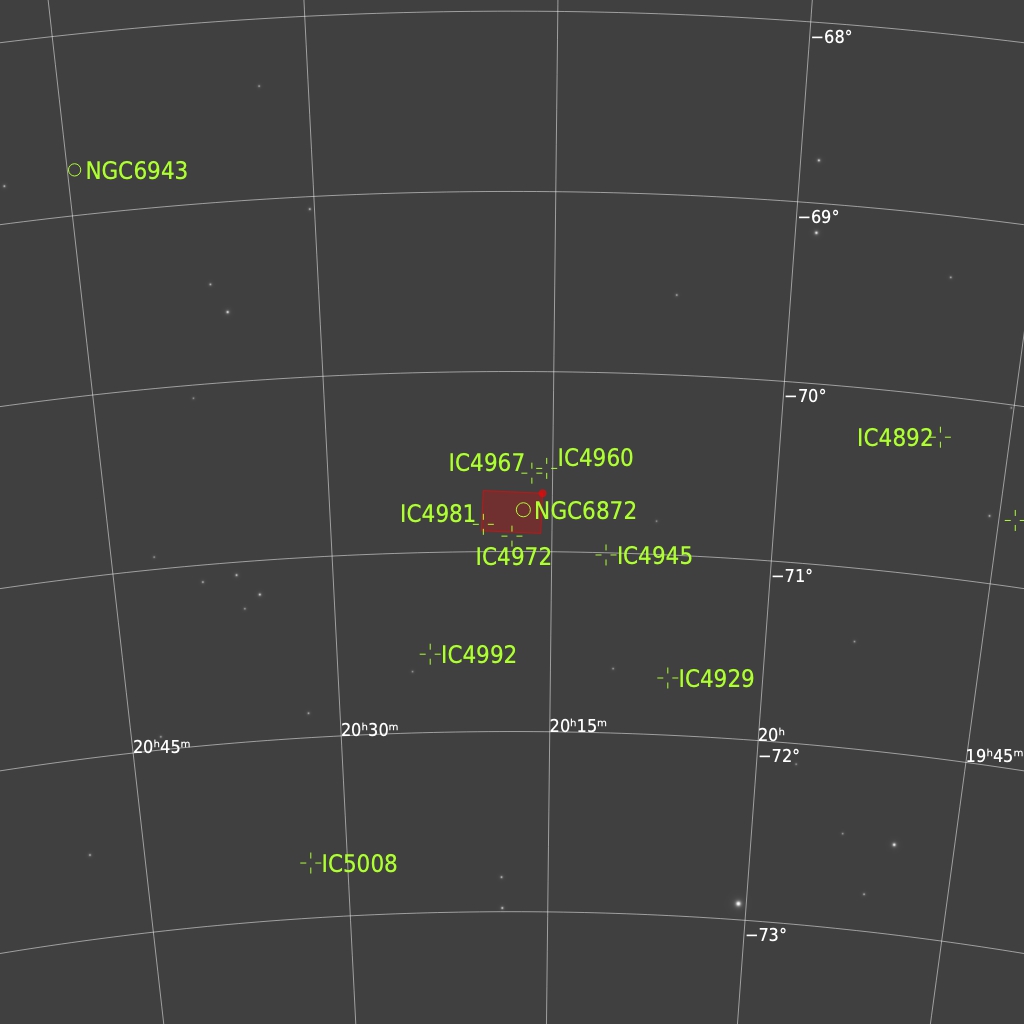The giant interacting galaxies
NGC 6872 & IC 4970
NGC 6872 is a large barred spiral galaxy in the constellation Pavo. It is 212 million light-years (65 Mpc) away from Earth and is approximately five billion years old. NGC 6872 is interacting with the lenticular galaxy IC 4970 (visible just at the bottom of NGC 6872 in this picture), which is less than one-twelfth as large. The galaxy has two elongated arms. NGC 6872 measures over 522,000 light years (160,000 pc), making it one of the largest known spiral galaxies. It was discovered on 27 June 1835 by English astronomer John Herschel.
When observed in the ultraviolet and mid-infrared, the central region NGC 6872 show old stars and low rates of star formation, with rates increasing along the spiral arms as distance from the core increases. The extended portions of both arms exhibit young star cluster formations with ages ranging from one to one hundred million years.
IC 4970 is a nearby lenticular galaxy, located only a few arcseconds away, and is known to be interacting with NGC 6872. A bright ultraviolet source was discovered at the end of the northeastern arm, around 290 thousand light years (90 kpc) from the nucleus, which may be a tidal dwarf galaxy formed out of the interaction between IC 4970 and NGC 6872. The bright ultraviolet nature of this cluster indicates that it contains stars less than 200 million years old, which roughly coincides with the timeframe of the collision.
NGC 6872 est une grande galaxie spirale barrée dans la constellation du Paon. Elle est située à 212 millions d’années-lumière (65 Mpc) de la Terre et est âgée d’environ cinq milliards d’années. NGC 6872 est en interaction avec la galaxie lenticulaire IC 4970 (visible juste au-dessous de NGC 6872 sur cette image), qui douze fois moins grande. La galaxie possède deux bras allongés. NGC 6872 mesure plus de 522 000 années-lumière (160 000 pc), ce qui en fait l’une des plus grandes galaxies spirales connues. Elle a été découverte le 27 juin 1835 par l’astronome anglais John Herschel.
Observée dans l’ultraviolet et l’infrarouge moyen, la région centrale de NGC 6872 présente d’anciennes étoiles et un faible taux de formation d’étoiles, ce taux augmentant le long des bras spiraux à mesure que la distance au noyau augmente. Les parties étendues des deux bras présentent de jeunes amas d’étoiles dont l’âge varie de un à cent millions d’années.
IC 4970 est une galaxie lenticulaire proche, située à seulement quelques secondes d’arc et en interaction avec NGC 6872. Une source de rayonnement ultraviolet brillante a été découverte à l’extrémité du bras nord-est, à environ 290 000 années-lumière (90 kpc) du noyau, qui pourrait être une galaxie naine, formée par l’interaction entre IC 4970 et NGC 6872. La nature ultraviolette de cet amas indique qu’il contient des étoiles de moins de 200 millions d’années, ce qui coïncide à peu près avec la période de la collision.
TECHNICAL DATA
ACQUISITION DETAILS
OPTICS Planewave CDK17 @ F/6.8
CAMERA SBIG STXL-11002 (AOX)
MOUNT Paramount ME
FILTERS Ha, L, R, G, B
LOCATION El Sauce Observatory, Rio Hurtado, Chile
DATE September 2020
EXPOSURES 25 hours (L 21 x 1200 sec, R 15 x 1200 sec, G 15 x 1200 sec, B 15 x 1200 sec, Ha 6 x 1800s)
PROCESSING SOFTWARE Pixinsight, CCDstack, Photoshop
COPYRIGHTS Martin Pugh & Nicolas Rolland

TARGET DETAILS
RA 20h 17m 42.8s
DEC -70° 46' 49.4"
SIZE 19.8 x 13.4 arcmin
ORIENTATION Up is 182 degrees E of N
CONSTELLATION Pavo
DISTANCE 210 million ly
MAGNITUDE 11.6
